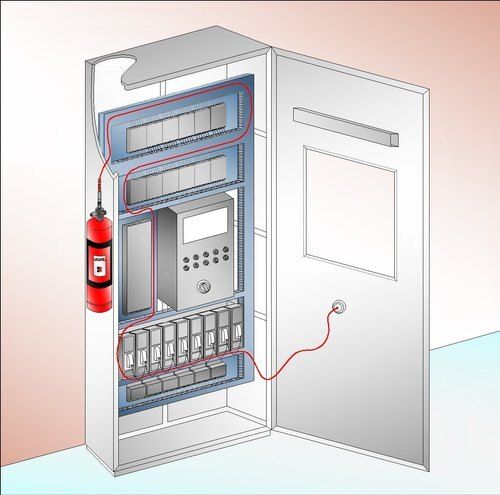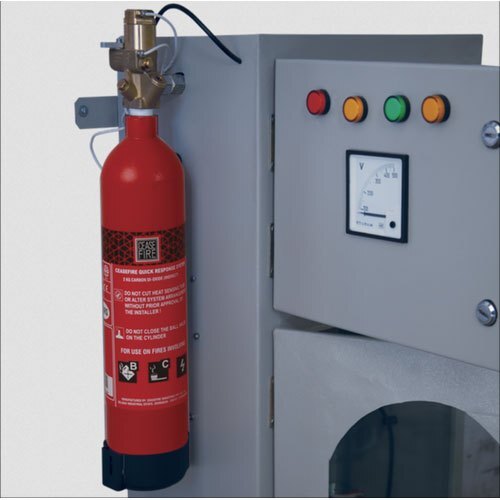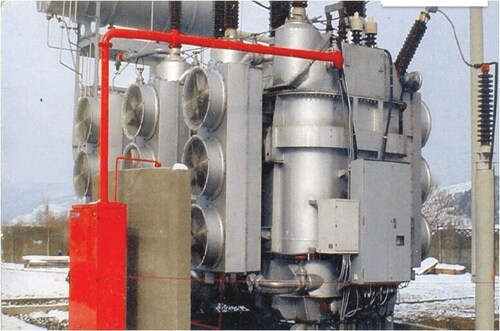- Home Page
- Company Profile
-
Our Products
- Fire Suppression Systems
- Hfc 227ea Auto Fire Extinguishing System
- Hfc227ea Total Flooding System
- Clean Agent Cylinderless System for Car
- Wind Turbine Fire Detection and Suppression System
- Vehicle Fire Protection System
- Fire Extinguishing System For Electrical Cabinets
- Aerosol Based Fire Suppression System
- Cylinder Less Tube Based Fire Detection Suppression Systems
- Hfc227ea Clean Agent Fire Extinguishers
- Carbon Steel Fm 200 Fire Suppression System
- Direct Tube Based Fire Suppression System
- Novac 1230 Fire Flooding Systems
- Clean Agent Fire Suppression System
- Heat Sensing Tube
- Clean Agent Cylinderless System
- Modular Clean Agent HFC236fa Extinguishers
- FK 5112 Suppression System
- Hfc 227ea Based Fire Suppression System
- Novec 1230 Flooding System
- Aerosol Fire Suppression System
- Dual Agent Retardant fire Suppression System
- Fire Suppression For Power Generators
- Car Fire Protection System
- Novec 1230 Clean Agent Suppression Systems
- High Voltage Transformer Fire Suppression System
- FM200 Fire Suppression System
- Mild Steel Novec 1230 Fire Suppression System
- Novec 1230 Fire Suppression System
- Clean Agent Fire Suppression System for Wind Turbine
- Bus Engine Fire Protection System
- Fire Trace System
- SEVO Tubing Suppression System
- Fire Detection And Fire Suppression System
- Heavy Vehicle Fire Suppression Systems
- Fire Sprinkler System Installation Service
- Vehicle Fire Suppression System
- Pre Engineered Fire Suppression System
- Server Rack Fire Suppression System
- Fire Suppression System (Capacitor Panel)
- Mild Steel Fire Suppression Systems
- Electrical Panel Detection Suppression System
- Fire Detection Tube Suppression System
- Fire Extinguishing System For Electrical Panel
- Electrical Panel Gas Suppression System
- Novec 1230 Fire Suppression System for Industrial
- Fm200 Gas Based Fire Suppression Systems
- FM200 Gas Based Fire Suppression Systems For Wind Turbines
- Tube Based Fire Suppression System
- Novec 1230 Fire Gas Suppression System For Electrical Panel
- Novec 1230 Fire Extinguishing System
- Novec 1230 Gas Suppression System For Wind Turbine Fire Suppression System
- Nitrogen Injection Transformer Fire Protection System
- Electrical Panel Fire Suppression System
- Dual Agent Retardant Fire Suppression System
- Diffusible FE36 Fire Suppression System
- Hazardous Cabinets Fire Suppression System
- Chemical Fire Suppression Systems
- Nitrogen NITFP System
- Automatic Fire Detection and Suppression System
- Novec 1230 Fire Suppression Systems
- Fire Suppression For Wind Turbines
- Bladder Tank Proportioning System
- Electrical Panel Fire Suppression
- Fk 5112 Fire Suppression System
- Fire Extinguishing Systems
- Fire Alarms And Detection Systems
- White Addressable Duct Detector
- UV IR Flame Detector
- Agni Sounder Hooter
- Addressable Fire Alarm System
- Fire Alarm System Amc Service
- Conventional Fire Alarm System
- Digital Addressable Fire Alarm System
- Aspirating Systems Smoke Detectors
- Agni Addressable Security Fire Alarm
- Fire Detection And Fire Alarm System
- Uv Ir Flame Detector System
- Ravel 2 zone Conventional Fire Alarm System
- Addressable Photoelectric Duct Detector
- Fire Alarm Sounder
- Fire Response Indicator
- Vesda Aspirating Smoke Detection System
- 4 Zone Addressable Fire Alarm System
- Ravel 4 zone Conventional Fire Alarm System
- Fire Detection Fire Alarm System
- Co2 Flooding/Suppression System
- Co2 Based Fire Suppression Systems
- CO2 Suppression System
- CO2 Fire Flooding
- Automatic Pipeline Co2 Fire Suppression System
- Co2 Fire Flooding System
- Co2 Cylinder Fire Suppression System
- In Direct CO2 Flooding System
- High Pressure Co2 Automatic Fire Extinguishing System
- Automatic Co2 Flooding System
- Automatic CO2 Flooding System
- Gas Based Co2 Flooding System
- Co2 Gas Fire Suppression System
- ELECTRICAL PANEL CO2 FLOODING SYSTEM
- Automatic Pipeline CO2 Fire Suppression System
- Co2 Fire Suppression System
- Passive Fire Protection
- Fire Extinguishers
- Twin Trolley Type Fire Extinguisher
- Co2 Fire Extinguisher Refilling Service
- Clean Agent Type Fire Extinguisher
- Amc For Fire Fighting System
- Co2 type fire Extinguisher
- Mild Steel Wet Chemical Fire Extinguisher
- Carbon Steel Abc Fire Extinguisher
- Automatic Ceiling Mounted D Type Fire Extinguisher
- Water Spray Sprinkler Systems
- Kanex Fire Extinguishers
- Fe36 Clean Agent Fire Extinguisher
- Modular Dry Chemical Powder Extinguishers
- Kitchen Fire Suppression System
- Kitchen Fire Suppression System
- Mild Steel Kitchen Fire Suppression
- Kitchen Hood Fire Suppression System
- Automatic Kitchen Fire Extinguishing System
- Kitchen Fire Extinguisher
- kitchen Nozzle Fire Suppression System
- Restaurant Kitchen Fire Suppression System
- Fire Suppression System For Commercial Kitchen
- Commercial Kitchen Fire Suppression System
- HW & MV Fire Protection System
- Commercial Gas Leak Detector
- Medium Velocity Water Spray System (MVWS)
- Transformer Fire Protection System
- Transformer Fire Prevention System
- Transformer Fire Suppression Systems
- Conveyor belt system fire protection system
- Nitrogen Injection Fire Protection System For Transformer
- High Velocity Water Spray System (HVWS)
- Fire Suppression Accessories
- Fire Hydrant System
- Clean Agent Gas Refilling
- Fire Fighting Foams
- Smoke Detector
- Ravel Beam Smoke Detector
- Addressable Photoelectric Smoke Detector
- Addressable Smoke Detector
- Fire Alarm Addressable Smoke Detector
- Battery Addressable Smoke Detector
- Polycarbonate Smoke Detector
- Agni Smoke Detector
- Conventional Optical Smoke Detectors
- Addressable Duct Smoke Detector
- Agni Wireless Smoke Detector
- White Polycarbonate Smoke Detector
- Manual Call Point
- Fire Retardant Fabric
- Fire Alarm Control Panel
- Heat Detector
- Beam Detectors
- Fire Door
- HW&MV Fire Protection
- Fire Cable Coating
- Fire Cable
- Public Address Systems
- Hydraulic Hose
- Fire Suppression Systems
- Contact Us

Hfc227ea Total Flooding System
71000 INR/Piece
Product Details:
- Color RED
- Dimension (L*W*H) METER Meter (m)
- Alarm YES
- Frequency HZ Hertz (HZ)
- Material M.S
- Input Power WATT Watt (W)
- Product Type FIRE SUPPRESSION SYSTEM
- Click to view more
X
Hfc227ea Total Flooding System Price and Quantity
- 71000 INR/Piece
- 1 Piece
Hfc227ea Total Flooding System Specification
- FIRE SUPPRESSION SYSTEM
- INDUSTRY
- METER Meter (m)
- WATT Watt (W)
- RED
- CELSIUS Celsius (oC)
- INDUSTRY
- M.S
- KG Kilograms (kg)
- HZ Hertz (HZ)
- YES
- 1 YEARS
Hfc227ea Total Flooding System Trade Information
- Cheque
- 100 Piece Per Month
- 10 Days
- Yes
- Free samples available with shipping and taxes paid by the buyer
- LOT
- Asia
- All India
- ISO & CE CERTIFICATE
Product Description
A Total Flooding System is a fire suppression system designed to quickly and effectively extinguish fires in enclosed spaces. These systems are commonly used in industrial settings, such as chemical plants, server rooms, electrical substations, and other high-risk areas where traditional firefighting methods might be ineffective or dangerous.
Here are some key features and components of a Total Flooding System:
1. Suppression Agent: Total Flooding Systems use a specialized fire suppression agent, which can be a gas, liquid, or a combination of both, to extinguish the fire. Common suppression agents include:
a. Clean Agents: These are gaseous agents like FM-200, Novec 1230, or Inergen, which work by removing heat and inhibiting the chemical reaction of combustion without leaving residue.
b. Wet Agents: These are typically water-based solutions like sprinklers or water mist systems that are used in some environments.
2. Detection and Activation: Total Flooding Systems are equipped with fire detection and alarm systems. When a fire is detected, these systems initiate the release of the suppression agent into the protected space. Various types of detectors, such as heat detectors, smoke detectors, or flame detectors, can be used.
3. Distribution System: The suppression agent is distributed throughout the protected area through a network of pipes, nozzles, and valves. The distribution system is designed to evenly disperse the agent to ensure effective fire suppression.
4. Control Panel: The control panel is the brain of the Total Flooding System. It monitors the detectors, controls the release of the suppression agent, and provides status information to operators.
5. Discharge Nozzles: These are strategically placed throughout the protected space to release the suppression agent. The design and placement of nozzles are critical to ensure proper coverage and distribution of the agent.
6. Activation Methods: Total Flooding Systems can be activated manually by personnel in the event of a fire, or they can operate automatically when the fire detection system senses a fire.
7. Safety Measures: Total Flooding Systems are designed with safety in mind. They often include alarms and warning signals to alert people in the area before the agent is discharged, allowing time for evacuation. Additionally, they may have mechanisms to prevent accidental discharge.
8. Agent Storage: The suppression agent is stored in cylinders or tanks at high pressure or in a liquefied state. The size and quantity of agent storage containers depend on the systems design and the size of the protected area.
Total Flooding Systems are effective at rapidly suppressing fires, but they require careful design, installation, and maintenance to ensure their reliability and safety. They are typically used in situations where the protection of valuable equipment or critical processes is of utmost importance and where traditional water-based fire suppression systems may not be suitable.
FAQ:
Q. What is a Total Flooding System?
Ans: A Total Flooding System is a fire suppression system designed to extinguish fires in enclosed spaces quickly. It typically uses specialized suppression agents, such as gases or liquids, to suppress fires effectively.
Q. Where are Total Flooding Systems commonly used?
Ans: Total Flooding Systems are commonly used in industrial settings, including chemical plants, server rooms, electrical substations, telecommunications facilities, and other high-risk areas where traditional firefighting methods may not be effective or safe.
Q. How do Total Flooding Systems work?
Ans: These systems detect fires through various types of detectors, activate the release of suppression agents, and distribute the agents throughout the protected area to extinguish the fire. The agents work by removing heat, inhibiting the chemical reaction of combustion, or other mechanisms, depending on the type of agent used.
Q. What types of suppression agents are used in Total Flooding Systems?
Ans: There are different types of suppression agents, including clean agents (e.g., FM-200, Novec 1230), wet agents (e.g., water mist), and others. The choice of agent depends on the specific fire risks and the environment.
Q. How are Total Flooding Systems activated?
Ans: Total Flooding Systems can be activated manually by personnel in the event of a fire or operate automatically when the fire detection system senses a fire. Automatic activation is common to ensure a rapid response.
Q. Are there safety measures in place for Total Flooding Systems?
Ans: Yes, safety measures are critical. Total Flooding Systems often include alarms and warning signals to alert people in the area before the agent is discharged, allowing time for evacuation. They may also have mechanisms to prevent accidental discharge.
Q. What is the role of a control panel in a Total Flooding System?
Ans: The control panel monitors the detectors, controls the release of the suppression agent, and provides status information to operators. It is a crucial component for the systems proper functioning.
Q. How are discharge nozzles placed in a Total Flooding System?
Ans: Discharge nozzles are strategically placed throughout the protected space to ensure even coverage and distribution of the suppression agent. Their design and placement are carefully calculated to maximize effectiveness.
Q. What maintenance is required for Total Flooding Systems?
Ans: Regular maintenance is essential to ensure the systems reliability. This includes inspections, testing of detectors, checking agent storage containers, and verifying the functionality of control panels and discharge equipment.
Q. Are there regulations and standards governing Total Flooding Systems?
Ans: Yes, various international and local regulations and standards govern the design, installation, and maintenance of Total Flooding Systems. Compliance with these standards is important for safety and effectiveness.
Q. Can Total Flooding Systems be integrated with other fire protection systems?
Ans: Yes, they can be integrated with other fire protection systems like sprinklers, smoke alarms, and emergency lighting to provide comprehensive fire safety.
Q. Do Total Flooding Systems cause any environmental concerns?
Ans: Some suppression agents used in Total Flooding Systems, especially certain halogenated agents, have raised environmental concerns due to their ozone-depleting potential. As a result, more environmentally friendly alternatives have been developed.
Q. How can I determine if a Total Flooding System is suitable for my facility?
Ans: To determine suitability, you should conduct a thorough risk assessment and consult with fire protection experts. They can help you assess the specific fire risks in your facility and recommend the most appropriate fire suppression solution, which may or may not be a Total Flooding System.
FAQs of Hfc227ea Total Flooding System:
Q: What is the temperature range for Hfc227ea Total Flooding System?
A: The temperature range for Hfc227ea Total Flooding System is in Celsius (oC).Q: What is the frequency for Hfc227ea Total Flooding System?
A: The frequency for Hfc227ea Total Flooding System is in Hertz (HZ).Q: What is the application of Hfc227ea Total Flooding System?
A: The application of Hfc227ea Total Flooding System is in the industry.Q: What is the color of Hfc227ea Total Flooding System?
A: The color of Hfc227ea Total Flooding System is red.Q: What is the material used for Hfc227ea Total Flooding System?
A: The material used for Hfc227ea Total Flooding System is M.S.Q: Does Hfc227ea Total Flooding System come with an alarm?
A: Yes, Hfc227ea Total Flooding System comes with an alarm.Q: What is the warranty period for Hfc227ea Total Flooding System?
A: The warranty period for Hfc227ea Total Flooding System is 1 year.Tell us about your requirement

Price:
Quantity
Select Unit
- 50
- 100
- 200
- 250
- 500
- 1000+
Additional detail
Mobile number
Email
Other Products in 'Fire Suppression Systems' category
" We mainly want inquiries from Gujarat, Rajasthan, Madhya Pradesh, Maharashtra, Goa. "







 English
English Spanish
Spanish French
French German
German Italian
Italian Chinese (Simplified)
Chinese (Simplified) Japanese
Japanese Korean
Korean Arabic
Arabic Portuguese
Portuguese